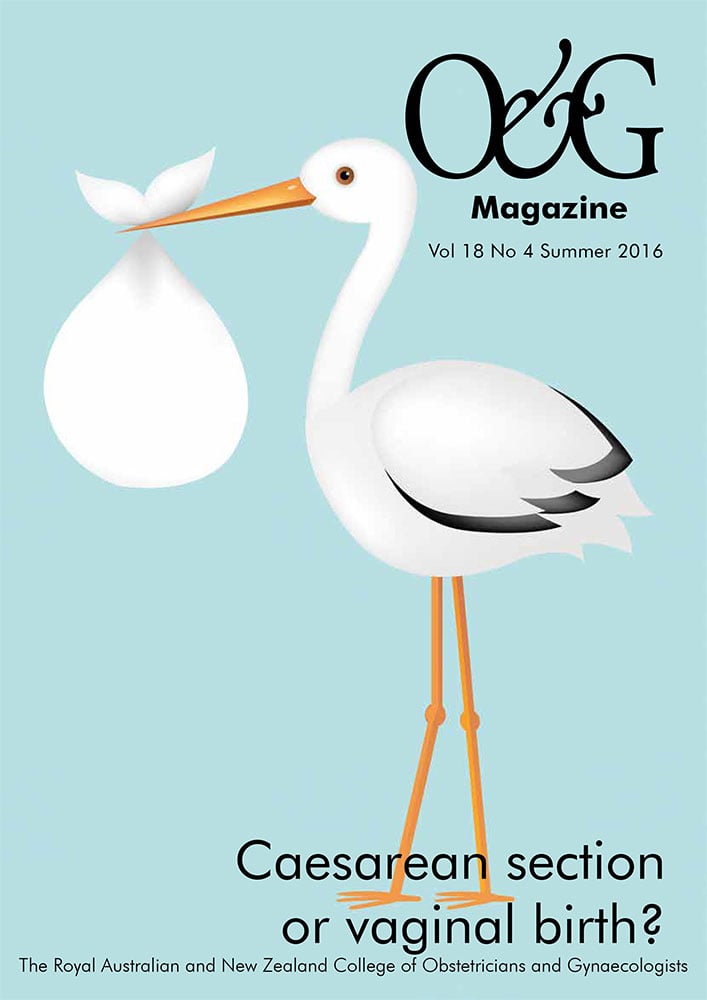We all want the best-possible outcomes for those we care for. The acceptable level of risk is, and arguably should be, very low for the woman, her baby and the caregiver.1
In cases where there are clear maternal or fetal indications for either vaginal birth (VB) or caesarean section (CS), the choice of method becomes easy. The woman with a major grade placenta praevia or with a fetus in the transverse lie should clearly have a CS. Most experts would agree that the woman with moderate mitral stenosis should have a VB where possible, with close attention paid to fluid balance, pain relief and a shortened second stage. But what is the safest route for the baby in cases where there is no strong indication for either VB or CS?
Before we begin the discussion, it is important to state that the available data are insufficient to comment with conviction on the question of which mode of birth is safest for neonates of mothers with a low-risk pregnancy. When comparing VB to CS it would be most appropriate to compare pre-labour CS without any medical or obstetric indication to VB, as opposed to comparing VB to all ‘elective’ CS, which would inevitably include procedures done for maternal and fetal obstetric and medical indications.2 Ideally, VB after CS should also be excluded from the analysis. Unfortunately, there is a distinct lack of studies comparing low-risk CS by maternal choice to planned VB.3 Randomised trials of this type would have innumerable methodological hurdles to clear in addition to the minefield of ethical issues. There also appear to be multiple reasons for the dearth of appropriate observational studies, including the fact that elective CS by maternal choice is a relatively new phenomenon, the numbers are relatively low (3% of all deliveries in a 2009 Australian study4), there is no coding system for it and record-keeping is poor.5 6 7 Thus the studies quoted below use all elective CS as a surrogate for low-risk CS by maternal choice versus planned VB.
CS has been associated with deleterious neonatal outcomes, such as increased respiratory morbidity, the possibility of inadvertent iatrogenic prematurity and a reduction in breastfeeding initiation, while also being associated with reduced fetal injury and perinatal morbidity when compared to VB.8
It is generally accepted that CS is associated with an increase in respiratory morbidity for the neonate, as well as admission to neonatal intensive care unit (NICU). Observational studies have shown that planned CS leads to an increase in transfer to the NICU (5.2% versus 9.8%P = <0.001)9 though it is recognised that this may be influenced by the fact that even elective CS births are more likely to be attended by paediatric staff than are uncomplicated VBs.
The rate of respiratory morbidity (including transient tachypnoea of the newborn and respiratory distress syndrome) for CS prior to labour (35.5/1000) is greater than for CS performed during labour (12.2/1000) or for VB (5.3/1000) (OR 6.8, 95% CI 5.2–8.9 P<0.001).10 Some studies have found that VB leads to an increase in the rate of APGARs <5 after VB,11 while others have failed to reproduce this finding.12 13 Of note, the increased risk of respiratory morbidity associated with CS is reduced if birth is delayed until after 39 weeks.14 15
There is a reduced rate of breastfeeding at six weeks postpartum among women who gave birth via pre-labour CS. By three and 24 months, this effect has disappeared and the rate of breastfeeding is similar among women who delivered by CS and those who had a VB. Unfortunately, the studies look at all elective CS and compare them with VB, as opposed to looking at low-risk, elective CS by choice versus planned VB. The caesarean groups studied will therefore include those performed for fetal and/or maternal reasons that may explain the delay in breastfeeding initiation, such as maternal intensive care unit (ICU) admission and NICU admission.16
Delivery via CS reduces the risk of serious fetal injury by avoiding complications that can occur in any vaginal birth, such as shoulder dystocia, as well as by avoiding the complications that can accompany instrumental delivery.
The incidence of brachial plexus injury after VB is 0.047–0.6 per cent versus 0.0042–0.092 per cent for CS. Using these figures, it is estimated that the number of CS that need to be performed to avoid one permanent brachial plexus injury would be 5000–10 000.17
The risk of intracranial injury is reduced in elective CS one in 2750 versus one in 1900 for spontaneous vaginal delivery. However, the risk increases if emergency operative delivery is required. The rates are one in 907 for CS in labour, one in 860 for ventouse delivery and one in 664 for forceps delivery.
Fetal injury does still occur with CS, but the rates are low. The rate of fetal injury with any CS (elective and emergency) is 1.1 per cent and 0.5 per cent for elective CS alone.
The majority of fetal injuries associated with CS are minor, such as superficial skin laceration.18 The rate of moderate to severe neonatal encephalopathy is 3.8/1000 term live births. Intrapartum hypoxia is the cause in four to 10 per cent of these cases and intrapartum factors superimposed on antenatal risk factors account for 25 per cent. Babies born by pre-labour elective CS have an 83 per cent lower risk of severe neonatal encephalopathy.19
The number of elective CS that would need to be performed in order to prevent one case of cerebral palsy is estimated to be 5000. (This includes cases caused by intrapartum and late antenatal events that may be prevented by CS at 39 weeks.)20
It has been argued that a policy of birth by 39 weeks (as generally occurs with elective CS) could lead to a reduction in stillbirth. This is based on US data from 2006 that show an increase in fetal death rate from 1.3/1000 at 37 weeks to 2.9/1000 at 39 weeks, and 4.6/1000 at 42 weeks. Few pregnancies last until 42 weeks these days. In fact, the reduction in Australia would be less as the gestation-specific stillbirth rates are lower than those from the USA. It must also be noted that the same reduction in stillbirth could be achieved by a policy of induction of labour at 39 weeks. A rational approach to early induction, based on risk factors for stillbirth, is likely to have an impact that exceeds other strategies for stillbirth prevention, but this is based on time of birth not method.21
A newly recognised and possibly deleterious association with CS is the impact on the neonatal intestinal microbiome. There is evidence that labour and VB allows seeding of the neonatal gastrointestinal (GI) tract with maternal intestinal and vaginal flora, which encourages a favourable microbiome in the child. It appears that CS bypasses this microbial seeding, thus leading to a less-favourable complement of intestinal micro-organisms. The long-term health impacts of this altered intestinal microbiome have not yet been fully elucidated, but there is some indication that it may alter development of the neonatal immune system and susceptibility to disorders ranging from obesity to allergic disorders (for example, asthma) and autoimmune diseases (for example, inflammatory bowel disease and Type 1 diabetes mellitus).22 23 A recent study has demonstrated that swabbing the vagina prior to CS and then placing the swab covered with maternal vaginal fluids on to the neonate after delivery caused a shift in the neonatal microbiome towards that seen in neonates born vaginally.24 It is yet to be demonstrated, however, whether this translates into an improvement in the long-term health consequences previously mentioned. This practice, known colloquially as ‘seeding’ has been the subject of controversy owing to the potential risk of transferring pathogens, such as group B strep, from the vagina and on to the baby.
So, which method of birth is the safest from the perspective of the neonate? An elective procedure is preferable to an emergency CS, and a spontaneous VB is preferable to an instrumental delivery in regards to both maternal and fetal outcomes. As mentioned above, the studies available compare all elective CS to planned VB and are plagued with confounding factors, meaning it is still difficult to say with any degree of authority whether low-risk CS by maternal choice is safer for the fetus than planned VB. A policy of elective CS for all would reduce the rate of late stillbirth but this would be due, in the majority, to the effect of delivery at 39 weeks of gestation, which could also be achieved by a policy of induction of labour at 39 weeks. Elective CS also significantly reduces the risk of neonatal trauma and hypoxic-ischaemic encephalopathy, but the numbers needed to treat are large. On the flipside, CS increases the risk of respiratory morbidity and alters the intestinal microbiome of the neonate. The degree of the former is somewhat reduced if delivery is delayed to after 39 weeks of gestation and the impact of the latter is still to be determined. On balance, it appears that elective CS allows avoidance of rare but severe complications with long-lasting effects, such as fetal trauma, while increasing the risk of short-term respiratory morbidity and reducing the short-, but not the long-term, breastfeeding rate. Where the microbiome sits in the argument is yet to be seen, but may have longer-term consequences. The important thing to remember here is that as obstetricians, we have two concerns – the woman and her baby, and despite the theme of this article, it is impossible for us to look at either of these two in isolation. In reality, it is the balance between risks and benefits for both that is important and needs to be assessed individually for each case. Arguably the most important message to take away from this is that there are risks and benefits to the fetus associated with labour and with elective CS and that our duty as obstetricians is to disclose these risks and benefits and help our patients make the most appropriate decision.
References
- Walker SP, McCarthy EA, Ugoni A, et al. Cesarean delivery or vaginal birth: a survey of patient and clinician thresholds. Obstet Gynecol. 2007;109(1):67-72.
- ACOG Committee on Obstetric Practice. Cesarean Delivery on Maternal Request. April 2013. Available from: www.acog.org/ Resources-And-Publications/Committee-Opinions/Committee-on-Obstetric-Practice/ Cesarean-Delivery-on-Maternal-Request
- Lavender T, Hofmeyr GJ, Neilson JP, et al. Caesarean section for non-medical reasons at term. Cochrane Database Syst Rev. 2012;3:CD004660.
- Robson SJ, Tan WS, Adeyemi A, et al. Estimating the rate of caesarean section by maternal request: anonymous survey of obstetricians in Australia. Birth. 2009;36(3):208-12.
- ACOG Committee on Obstetric Practice. Cesarean Delivery on Maternal Request. April 2013. Available from: www.acog.org/ Resources-And-Publications/Committee-Opinions/Committee-on-Obstetric-Practice/ Cesarean-Delivery-on-Maternal-Request
- Lavender T, Hofmeyr GJ, Neilson JP, et al. Caesarean section for non-medical reasons at term. Cochrane Database Syst Rev. 2012;3:CD004660.
- D’Souza R, Arulkumaran S. To ‘C’ or not to ‘C’? Caesarean delivery upon maternal request: a review of facts, figures and guidelines. J Perinat Med. 2013;41(1):5-15.
- ACOG Committee on Obstetric Practice. Cesarean Delivery on Maternal Request. April 2013. Available from: www.acog.org/ Resources-And-Publications/Committee-Opinions/Committee-on-Obstetric-Practice/ Cesarean-Delivery-on-Maternal-Request.
- Kola˚s T, Saugstad OD, Daltveit AK, et al. Planned cesarean versus planned vaginal delivery at term: Comparison of newborn infant outcomes. Am J Obstet Gynecol. 2006;195:1538-43.
- Morrison JJ, Rennie JM, Milton PJ. Neonatal respiratory morbidity and mode of delivery at term: influence of timing of elective caesarean section. BJOG. 1995;102(2):101-6.
- Morrison JJ, Rennie JM, Milton PJ. Neonatal respiratory morbidity and mode of delivery at term: influence of timing of elective caesarean section. BJOG. 1995;102(2):101-6.
- Kola˚s T, Saugstad OD, Daltveit AK, et al. Planned cesarean versus planned vaginal delivery at term: Comparison of newborn infant outcomes. Am J Obstet Gynecol. 2006;195:1538-43.
- Contag A, Clifton RG , Bloom SL, et al. Neonatal Outcomes and Operative Vaginal Delivery Versus Cesarean Delivery. Amer J Perinatol. 2010;27(6):493-499.
- Morrison JJ, Rennie JM, Milton PJ. Neonatal respiratory morbidity and mode of delivery at term: influence of timing of elective caesarean section. BJOG. 1995;102(2):101-6.
- Zanardo V, Simbi AK, Franzoi M, et al. Neonatal respiratory morbidity risk and mode of delivery at term: influence of timing of elective caesarean delivery. Acta Paediatr. 2004;93(5):643-7.
- NIH State-of-the-Science Conference Statement on cesarean delivery on maternal request. NIH Consensus State Sci Statements 2006;23:1-29. Available from: http:// consensus.nih.gov/2006/cesareanstatement. pdf.
- Hankins GD, Clark SM, Munn MB. Cesarean section on request at 39 weeks: impact on shoulder dystocia, fetal trauma, neonatal encephalopathy, and intrauterine fetal demise. Semin Perinatol. 2006;30(5):276-87.
- Hankins GD, Clark SM, Munn MB. Cesarean section on request at 39 weeks: impact on shoulder dystocia, fetal trauma, neonatal encephalopathy, and intrauterine fetal demise. Semin Perinatol. 2006;30(5):276-87.
- Hankins GD, Clark SM, Munn MB. Cesarean section on request at 39 weeks: impact on shoulder dystocia, fetal trauma, neonatal encephalopathy, and intrauterine fetal demise. Semin Perinatol. 2006;30(5):276-87.
- Hankins GD, Clark SM, Munn MB. Cesarean section on request at 39 weeks: impact on shoulder dystocia, fetal trauma, neonatal encephalopathy, and intrauterine fetal demise. Semin Perinatol. 2006;30(5):276-87.
- Hankins GD, Clark SM, Munn MB. Cesarean section on request at 39 weeks: impact on shoulder dystocia, fetal trauma, neonatal encephalopathy, and intrauterine fetal demise. Semin Perinatol. 2006;30(5):276-87.
- Renz-Polster H, David MR, Buist AS, et al. Caesarean section delivery and the risk of allergic disorders in childhood. Clin Exp 2005;35:1466-72.
- Neu J, Rushing I. Cesarean versus Vaginal Delivery: Long term infant outcomes and the Hygiene Hypothesis. Clin Perinatol. 2011;38(2):321-331.
- Dominguez-Bello, MG, et al. Partial restoration of the microbiota of cesarean-born infants via vaginal microbial transfer. Nat Med. 2016. Available from: http:// dx.doi.org/10.1038/nm.4039.







Leave a Reply